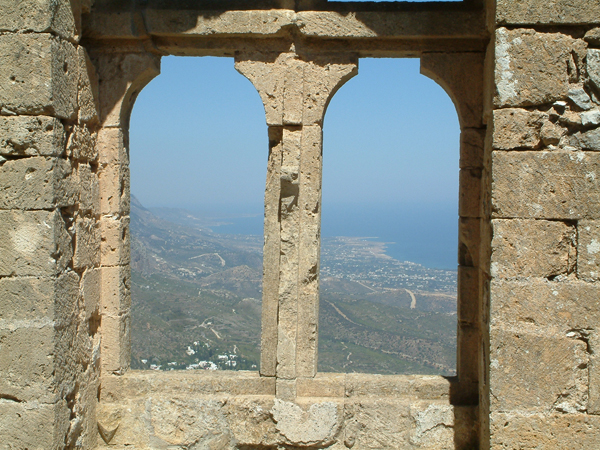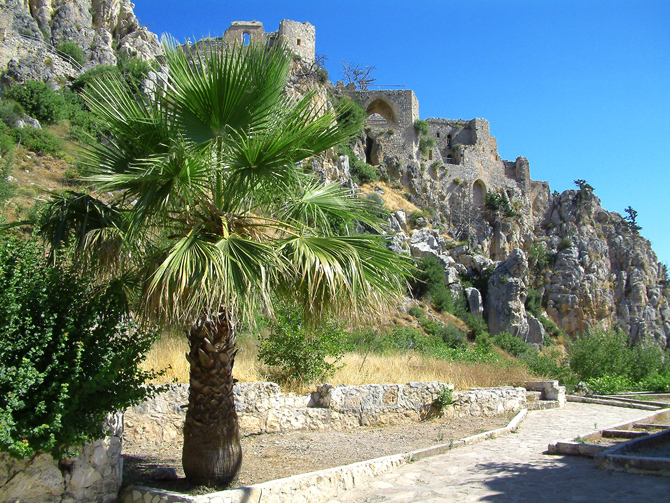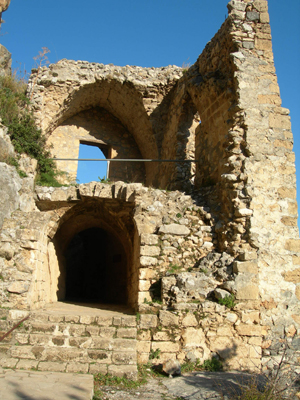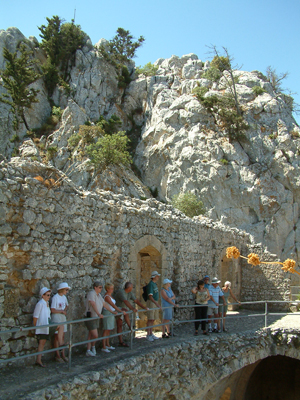North Cyprus Kyrenia
St. Hilarion Castle
History of the castle
Byzantine rule
The mountain lookouts were built early in the 7 th century to resist against Arab raiders like was Buffavento and Kantara Castle . The first references to the castle are found in the 1191 records. The castle was one of the last taken by the Crusaders at that time. During Byzantine period major fortifications were built.
Frankish period
Later under the rule of Lusignans, St Hilarion became the focus of a four-year struggle between Holy Roman Emperor Frederick II and Regent John d' Ibelin for control of the island, won by John's army at the battle of nearby Ag ídra (at present A girdag ) in 1232. During the subsequent 140 years of peace, royal apartments for the knights were added as well as the cisterns to collect water and chapels for worship. The castle served both as a summer palace as the knights would practice their martial skills on the jousting grounds, and a refuge from the plague during 1349-1350.

Genoese
In 1373 when the Genoese invaded, the castle again acquired military significance as the retreat of under-age King Peter II. His uncle and regent John of Antioch was misled by his hostile sister-in-law Eleanor of Aragon. After she gossiped that his bodyguards of Bulgaria were treasonous, prince had them thrown one by one from tower now known as Prince John's tower.
Venetians
When the Venetians took over the island in 1489 they dismantled the castle speculating that the castle is worthless in warfare as it would not have withstood the power of cannon. They left the castle crumbling, unwanted and uninhabited.
Turkish Cypriots military army
In 1964 the beleaguered Turkish Cypriots saw the castle useful, using it as headquarters of their main enclave which included several Turkish communities on the main Kyrenia-Nicosia road. A small garrison of teenage TMT (Turk M üdafaa Teskilati) activists was able to take control of the castle and fend off EOKA-inspired attacks. With passage on the traditional main highway prohibited to Greek vehicles, and possible only in slow, UN-escorted convoy, the central government was forced to build a bypass via Be sparmak (Pentadactylos). In 1974 St Hilarion and its surrounding enclave were a primary goal of Turkish paratroop landings early on July 20.
Castle tour
The castle is built in three separate parts, each of them is self-contained and used to be inhabited by its own community of servants, knights, nobles and royalty. The three parts of the castle blend into the rocky landscape upon which it has been grafted.

Lower ward
Visitors enter by the barbican and the main gate beyond the ticket booth into the lower ward, which was used as the main garrison and stabling area . The wood-and-plaster work is marked by the 1995 bush fire . Main entrance has some fine carvings. Outer bailey wall has battlements linked by six semi-circular towers and a walkway for the sentries between each tower. In the lower ward there were once armoury and stores. After entering the main gate the path climbs to the left and follows a course along the line of the southernmost battlements. Underground on the left there is a large cistern, and as the pathway turns to the right there is another one and a stable block.
Middle ward
A meandering path leads you up to the second ward. On the right are two flights of steps, the first will take you to the floor above the entrance gate and provides a good vantage point over the lower ward. With the second staircase you will reach the Byzantine chapel, an earliest structure in the castle. After the restoration, the remains of frescoes are still dimly visible on the walls. On the outer wall at the western end, the French additional masonry has been broken away and through the gaps one can see the colours of some late Byzantine wall paintings. The French used the chapel for Catholic worship and it has several small rooms leading off it: sacristy, confessional and private chapel. Wandering along the dozens of still extant rooms of the middle ward takes some time. These include the monastic refectory, later a royal banqueting hall. At the eastern end of the passage there is the vaulted belvedere, the place where ladies would sit and watch the knights on the jousting ground below. Doorways lead off into small chambers, and flights of steps lead round the walls of the apartments, now largely roofless. There are a couple of latrine rooms on this route. Following the steps higher, one can experience a spectacular view over the Kyrenia coast. Descending the stairs there are some storerooms and barracks on the right. After taking a few steps the path continues upward to an enormous cistern for the storage of vital water that was built partly into the face of the mountain and on the eastern side supported by massive buttresses.


Upper ward
The route to the upper ward is long and winding. Just before reaching the entrance arched gate to the topmost section of the castle, there is a junction. To the left there is Prince John's tower that is worth visiting. According to the legend, Prince John of Antioch, convinced that Bulgarian guards were planning to kill him, had them thrown over the steep cliff to their death. The main entrance is guarded by a strong gate and around the courtyard are more royal apartments, kitchens and ancillary chambers. Returning to level ground the path passes a fenced-in aqueduct and cistern full of mud-puddle and leads into only relatively intact buildings that comprised the royal apartments on this level. These are the remains of the Great Hall, above is the boudoir of the plotting Queen Eleanor. The panoramic view through the Queen's window, carved in the Gothic style, is truly magnificent. If by this time you have any breath left, it is uplifting just to sit and gaze out over the countryside towards the mountain village of Karaman and the coastline of Kyrenia which is 730m lower in elevation. On a clear day you can spot the Taurus Mountains in Turkey, more than 70km away.
| page 1 page 2 |
Related links








